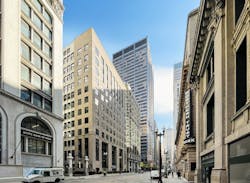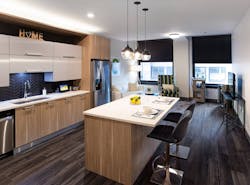Adaptive reuse: 5 benefits of office-to-residential conversions
In 2021, FitzGerald completed renovations on Millennium on LaSalle, a 14-story building in the heart of Chicago’s Loop. Originally built in 1902, the former office building now comprises 211 apartment units and marks LaSalle Street’s first complete office-to-residential conversion.
It certainly won’t be the last. In Chicago’s central business disrict, there is a growing recognition that vacant or underutilized office buildings can and should be repurposed to serve other needs, particularly to fulfill the demand for more housing.
The City of Chicago recently put out the LaSalle Reimagined Initiative IFP, which, in the words of Department of Housing Commissioner Marisa Novara, aims to “create hundreds of homes, including much-needed affordable housing in the city's central business district.”
OFFICE-TO-RESIDENTIAL – A NATIONAL TREND
This trend goes far beyond Chicago. A December 2022 study by RentCafe found that there were 77,000 apartments under conversion nationwide, of which 11,000 are apartment conversions from office buildings—in just the last two years
Still, not every building is a candidate for conversion, and the process demands a highly skilled team.
Any conversion project requires critical consideration of the existing building conditions: the size of the floorplate, the placement of the building on the block, the viability of the MEP systems, even the condition of the window.
Let's look at those five benefits of adaptive reuse, office-to-residential.
1 Construction cost and speed of delivery.
Adaptive reuse projects have the potential for delivery to the market faster than new construction. Even considering that existing HVAC, electrical, and plumbing systems will likely have to be replaced, the overall cost will likely be 10-15% less than a new build.
2 Location, naturally
Existing buildings can offer the benefit of location that new builds may not. Many underused office buildings occupy prime real estate in central locations. Repurposing these spaces for apartments or condominiums will enable more people to live downtown, closer to where they work, and with convenient transportation nearby.
3 Guarantee of investment
With the recent surge in remote work and the future of the office still up for debate, apartment projects are currently a better investment guarantee for developers than offices.
Depending on the building, developers may be eligible for historic rehabilitation tax credits. For example, buildings on the LaSalle Street historic district in Chicago are in a National Register Historic District and are eligible for tax credits.
Chicago’s Loop is a much more mixed-use neighborhood now than it was two decades ago. According to the Chicago Loop Alliance, an estimated 3,700 residents moved to the Loop between 2020 and 2022.
4 Neighborhood revitalization
Office-to-apartment conversions are an important trend for revitalizing our downtowns. Creating more opportunities for housing amid a deep housing crisis will help shape balanced neighborhoods, especially with city requirements that a certain percentage of units be classified as affordable.
Of course, creating more residential spaces alone won’t save our downtown—it must be paired with access to grocery stores, retail, services, and cultural offerings —but it will be a huge contributing factor to more active and vibrant neighborhoods.
Revitalizing Millennium on LaSalle enabled the preservation of historic features such as the marble-clad lobby, the ornate central stair, and the 1940s remodel of the LaSalle Street facade.
5 Sustainability
From an environmental standpoint, one of the most sustainable things we as architects can do is to renovate an existing building rather than demolishing and starting new. In Chicago, we have such a wealth of great architecture downtown – we need to save these buildings where we can. The change of use also provides the opportunity for replacing outdated and inefficient mechanical, plumbing, and electrical equipment with more efficient and resource-conscious systems.
The growing trend of office-to-residential conversions will undoubtedly help to shape our cities in the years to come. Nor do these kinds of conversions have to tackle an entire building: we are seeing interest in converting a few floors into residential units.
Anything we can do to create a more vibrant, diverse, and sustainable future for our nation’s urban centers will be a step in the right direction.
ABOUT THE AUTHOR
Richard Whitney is a vice president with the Chicago architecture firm FitzGerald. Since 1990, he has been a leader in the firm’s pursuit of senior housing, affordable housing, and hospitality projects. Whitney helps developers and owners realize their vision for their multifamily communities, hotels, conference centers, and restaurants, and is a champion of the adaptation and rehabilitation of older buildings to energize the performance of existing assets.
Whitney received his BS in architecture from Lawrence Technological University and is a member of Lambda Alpha Ely chapter and the National Trust for Historic Preservation. He is a licensed architect in Illinois, Michigan, and Texas.


